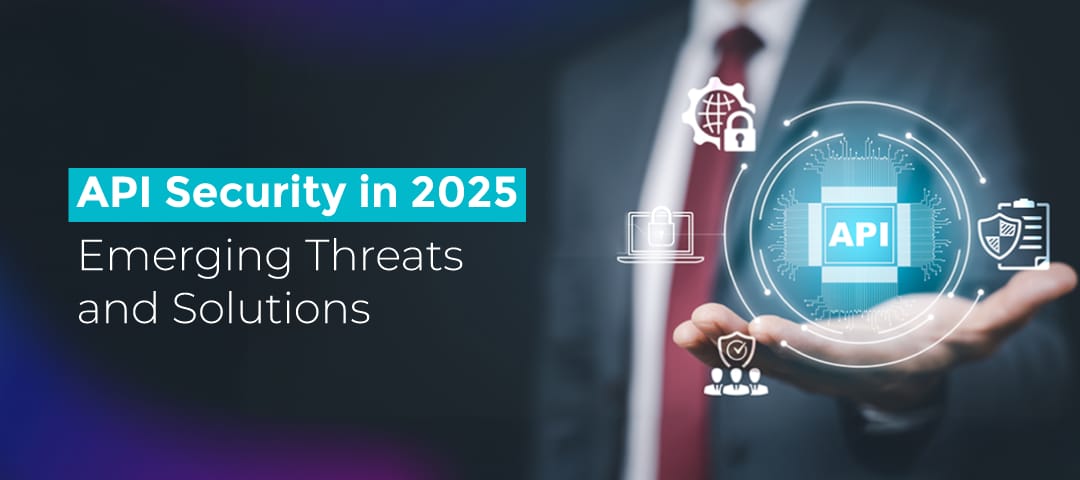API Security in 2025: Emerging Threats and Solutions

APIs continue to be the lifeblood of modern tech ecosystems even in 2025, powering everything from cloud services to mobile applications. As organizations scale, the risks associated with API security have become more pronounced. A study highlights that 57% of organizations witnessed an API-related data breach in the last two years. For businesses relying on APIs as part of their digital infrastructure, engaging with trusted API development services is critical to ensuring secure, resilient solutions.
For instance, broken user authentication, broken object-level authorization, shadow and zombie APIs, Server-Side Request Forgery, and prompt injection are among the top threats that can compromise business operations and user trust. However, adopting robust solutions like implementing OAuth 2.0 and Multi-Factor Authentication (MFA), applying Role-Based Access Control (RBAC), conducting regular API discovery and inventory management, and using input sanitization and AI-based threat detection can effectively address these flaws.
As a CTO, it’s crucial to stay ahead of these evolving challenges. This blog explores the current API landscape, emerging API security threats and their solutions, and the future of API security.
API Landscape in 2025: A Quick Overview
The API landscape is experiencing a transformative shift, evolving from basic data interchange mechanisms to sophisticated, AI-powered platforms that drive business innovation. One of the most significant changes is the deep integration of AI, which is not just enhancing the performance and security of APIs but also automating lifecycle management and anticipating user needs.
AI-driven solutions, such as autonomous AI agents, are handling complex tasks like customer service, fraud detection, and financial advice, leveraging data from multiple APIs. In parallel, AI-powered API management systems optimize performance in real-time, predicting demand and improving security.
Security is another major focus, with APIs transitioning from potential vulnerabilities to resilient, well-governed components. Advanced observability tools and AI/ML-driven security mechanisms are becoming critical in detecting and mitigating threats.
How to Detect API Vulnerabilities
There are several effective methods to identify API weaknesses before attackers do:
- Automated Scanning Tools: Tools like OWASP ZAP or Burp Suite are excellent for quickly identifying flaws in your API. These tools scan for common vulnerabilities such as injection points, improper authentication, and data leaks.
- Manual Penetration Testing: Automated tools alone can’t catch everything. Regular penetration testing by security experts will help identify complex vulnerabilities that scanners might miss. This should include testing edge cases and unusual inputs.
- Regular API Audits: Conducting a thorough audit of your API’s design and security controls is essential. An audit checks for outdated protocols, improperly implemented encryption and unpatched vulnerabilities that could put your API at risk.
- Fuzz Testing: Fuzz testing allows you to send random data to your API and monitor how it reacts. This can reveal hidden weaknesses, such as buffer overflows or other loopholes in your API endpoints.
- Behavioral Monitoring: Implement monitoring tools that can detect unusual API behavior. By tracking usage patterns and identifying deviations from the norm, you can spot potential attacks like data exfiltration or brute-force attempts early.
What Are the New API Security Threats in 2025 and Their Fixes?
APIs have become increasingly essential to business operations, enabling everything from e-commerce transactions to cloud integrations. However, with their growth comes the heightened risk of cyberattacks. Let’s examine some of the key security risks facing APIs, along with API security best practices to mitigate these threats:
1. Broken User Authentication
What It Is:
Broken User Authentication occurs when APIs fail to securely authenticate users, allowing attackers to impersonate legitimate users. This happens due to weak password policies, ineffective session management, or improper token handling.
Why It Matters:
A breach in authentication can lead to unauthorized access to sensitive data or systems, leaving your organization vulnerable to attacks such as data theft or manipulation.
Solutions:
- Implement OAuth 2.0 and OpenID Connect: These modern, industry-standard API authentication methods provide secure token-based authentication.
- Enforce Multi-Factor Authentication (MFA): Adding an extra layer of verification (like SMS or app-based authentication) makes it harder for attackers to impersonate users.
- Secure Session Management: Regularly refresh tokens, use secure cookies, and enforce session timeouts to protect against session hijacking.
2. Broken Object Level Authorization
What It Is:
Broken Object Level Authorization (BOLA) happens when APIs fail to check whether a user has permission to access a specific object or resource. This loophole allows attackers to bypass authorization checks and gain unauthorized access to sensitive data.
Why It Matters:
Imagine an employee accessing someone else’s payroll information or customer records. In industries like finance, healthcare, and e-commerce, these breaches can lead to serious consequences, including financial loss and reputational damage.
Solutions:
- Use Role-Based Access Control (RBAC): Implement role-based access where each user has access only to data and objects they need.
- Consistent Authorization Checks: Ensure that every API call checks for proper authorization before accessing any object.
- Implement the Least Privilege Principle: Grant only the minimum level of access necessary for a user or process to perform their tasks.
3. Broken Object Property Level Authorization
What It Is:
This threat occurs when the API does not properly verify access rights at the property level within an object. For example, an API might allow access to a customer profile but fail to secure certain fields like email or payment details, letting attackers view or modify them.
Why It Matters:
Sensitive data, like payment details or personal addresses, if not protected, can lead to privacy violations or fraud, especially in sectors dealing with financial transactions and individual health data.
Solutions:
- Granular Access Controls: Implement fine-grained permissions for every object property to limit access based on the user’s role.
- Policy Enforcement: Define and enforce clear policies for what each role can access, both at the object and property levels.
- Regular Audits and Testing: Conduct regular security audits to ensure that no unauthorized access to object properties occurs.
4. Shadow and Zombie APIs
What It Is:
Shadow APIs are APIs that are unknowingly exposed by internal teams or third-party developers, often without security controls. Zombie APIs are outdated or unused APIs that still exist in the codebase, potentially with vulnerabilities. Both can be entry points for attackers.
Why It Matters:
Shadow APIs can allow unauthorized access to sensitive systems or data. Zombie APIs, though inactive, may still have flaws that could be exploited by attackers if not properly disabled.
Solutions:
- API Discovery and Inventory Management: Regularly audit and maintain an inventory of all APIs in your environment to ensure there are no hidden or forgotten APIs.
- Proper Decommissioning: When APIs are no longer needed, make sure they are completely removed from the system, including any associated keys, configurations, or access.
- Access Control and Security Checks: For any API, whether active or dormant, ensure proper authentication, authorization, and encryption are enforced.
5. Server-Side Request Forgery (SSRF)
What It Is:
SSRF attacks happen when an attacker manipulates an API to make unauthorized requests from the server to internal or external systems. By exploiting SSRF vulnerabilities, an attacker can gain access to internal resources, like databases, or even target third-party services.
Why It Matters:
An attacker who successfully exploits SSRF can breach internal systems, exfiltrate data, or launch attacks on other services. This threat is extremely dangerous, especially in cloud-based and microservice architectures.
Solutions:
- Input Validation: Always validate and restrict the URLs or IP addresses that the server can access to prevent unauthorized access to internal resources.
- Limit Outbound Requests: Configure your server only to allow requests to trusted and predefined destinations, blocking any unapproved external requests.
- Use Network Segmentation: Segregate sensitive internal services from publicly accessible APIs to reduce the impact of SSRF.
6. Open-Source Supply Chain Attacks
What It Is:
Open-source supply chain attacks target loopholes in third-party libraries or APIs on which your application depends. By compromising an open-source package, attackers can inject malicious code into your systems or steal sensitive information.
Why It Matters:
The reliance on open-source libraries means that an attack on a popular library can impact thousands of organizations using it. Supply chain attacks are difficult to detect and can silently infect systems.
Solutions:
- Regularly Update Dependencies: Continuously monitor and update open-source libraries to ensure you are not using outdated, vulnerable versions.
- Use Dependency Scanners: Implement automated tools like Snyk or GitHub Dependabot to regularly scan for loopholes in third-party libraries.
- Vet Libraries and Contributors: Ensure that any open-source libraries you use are well-maintained and trusted, preferably with active communities and verified contributors.
7. Prompt Injection
What It Is:
Prompt injection is a relatively new threat that targets AI-driven APIs, especially those using natural language processing (NLP). Attackers inject malicious prompts into AI models, manipulating them to produce harmful outputs or reveal confidential information.
Why It Matters:
AI-based systems are increasingly used to interact with customers or process sensitive data. If an attacker manipulates the AI through prompt injection, it can lead to misinformation, security breaches, or data leaks.
Solutions:
- Input Validation and Sanitization: Always sanitize user input to ensure that it does not contain harmful commands or scripts.
- AI-Specific Security Controls: Implement threat detection specifically designed for AI models, which can monitor for malicious inputs.
- Model Hardening: Regularly test and update AI models to defend against prompt injection attempts, ensuring they handle edge cases securely.
The Challenges of Fixing API Vulnerabilities
Below are the major hurdles organizations face when trying to address flaws in their APIs:
- Balancing Speed and Security: Many times, the pressure to deliver APIs quickly leads to sacrificing thorough security measures. You can manage this tension by building a culture where security isn’t an afterthought but a key part of the development process.
- Legacy Systems and Technical Debt: More often, older systems don’t meet modern security standards. Fixing vulnerabilities in legacy APIs can be a daunting task, especially if they were built with outdated frameworks. Updating these systems may require significant rework, which can be resource-intensive.
- Integration with Multiple Services: APIs connect to various services, including third-party platforms. Securing these APIs requires understanding all the connections and ensuring that each one is secure. However, this can be difficult if you don’t have full visibility into all integrated systems.
- Scalability of Security Practices: As your organization grows and APIs become more distributed, scaling security practices across all endpoints becomes increasingly challenging.
- Resource Constraints: Not all organizations have dedicated security teams to focus on every potential vulnerability. This resource shortage means that critical patches are delayed or skipped altogether.
The Future of API Security: Trends to Watch
API security will evolve to keep pace with the rising complexity of digital ecosystems. Let’s take a closer look at the key API security trends in 2025:
- Zero Trust API Security: Instead of trusting any API request by default, the Zero Trust model assumes no request is safe. This means APIs will continuously verify every request, user, and device before granting access.
- AI and Machine Learning: These technologies will help identify patterns and predict attacks even before they happen. For instance, AI can analyze traffic anomalies in real-time, automatically flagging potential threats.
- DevSecOps: DevSecOps will be a core component of the API development lifecycle. Security will be integrated from the very beginning of the API design and throughout the deployment process, ensuring that flaws are identified and addressed early.
Conclusion
As API security threats continue to evolve, it’s crucial that your strategies evolve alongside them. By understanding why vulnerabilities arise and taking steps to detect and address them early, you can protect your organization from potential risks.
Emphasizing strong authentication, encryption, and regular security testing will go a long way in securing your APIs. It’s also essential to stay vigilant against potential weaknesses introduced by legacy systems or third-party integrations. Looking ahead, the future of API security will be shaped by cutting-edge technologies like AI and machine learning, which will enable businesses to predict and mitigate threats more swiftly and accurately.
FAQs
1. What are some emerging API security risks specific to AI-driven APIs in 2025?
AI-driven APIs are vulnerable to prompt injection attacks, where attackers manipulate input to generate malicious outputs. Additionally, AI models may also be exploited through adversarial inputs that disrupt their intended functionality.
2. How can businesses balance the need for rapid API development with robust security measures?
To balance speed with security, organizations should integrate security practices early in the development process, using automated testing tools and promoting a culture where security is prioritized alongside innovation.
3. How can organizations effectively manage third-party API dependencies to minimize security risks?
Organizations should regularly monitor and update third-party libraries, use automated dependency scanners, and vet all open-source components to ensure they are secure and maintained by trusted contributors.
4. What are the major challenges businesses face when implementing a Zero Trust security model for APIs?
Implementing Zero Trust requires continuously verifying every request, which can introduce complexity in managing permissions and maintaining consistent access policies, especially across distributed environments.
5. In what ways can advanced observability tools enhance API security in real time?
Observability tools provide real-time visibility into API traffic and performance, enabling teams to quickly identify unusual patterns or security anomalies, which can help prevent data breaches or other malicious activities.



